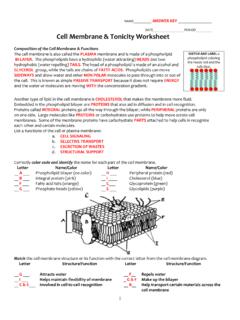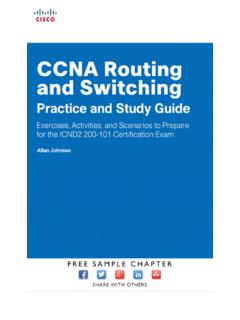Transcription of acket Tracer - Configuring IPv6 Static and Default Ro utes
1 6T IOB 2013 Cisco PThis packet tPv6 AddreObjectivesPart 1: ExPart 2: CoPart 3: VeBackgrounIn this actmanually d/or its affiliates. packet Ttracer is in messing TabDevice R1 R2 R3 PC1 PC2 PC3 xamine the Nonfigure IPv6erify Connecnd tivity, you will by the netwoAll rights reserveTracer - Cmy hand out ble Interface G0/0 S0/0/0 G0/0 S0/0/0 S0/0/1 G0/0 S0/0/1 NIC NIC NIC Network and 6 Static and ctivity configure IPvrk administraed. This documeConfigufolder, SemIPv6 Ad2001:DB8:12001:DB8:12001:DB8:12001:DB8 :12001:DB8:12001:DB8:12001:DB8:12001:DB8 :12001:DB8:12001:DB8:1 Evaluate theDefault Rouv6 Static and dtor in order toent is Cisco Publiring IPvmester 2, thenddress/Prefix1:1::1/64 1:A001::1/641:2::1/64 1:A001::2/641:A002::1/641:3::1/64 1:A002::2/641:1::F/64 1:2::F/64 1:3::F/64 e Need for Sttes Default routeso create a Staticn New Semex DeN/AN/AN/AN/AN/AN/AN/AFE80FE80FE80tatic Routings.
2 A Static rouute that is reliac and Deester 2 packefault Gatewa0::1 0::2 0::3 g ute is a route table and safeefault Roket Tracer file ay that is enteree. There are foPage 1 of 3 outes es d our packet Tracer - Configuring ipv6 Static and Default Routes 2013 Cisco and/or its affiliates. All rights reserved. This document is Cisco Public. Page 2 of 3 different Static routes used in this activity: a recursive Static route; a directly attached Static route; a fully specified Static route; and a Default route. Part 1: Examine the Network and Evaluate the Need for Static Routing a. Looking at the topology diagram, how many networks are there in total? 5 b. How many networks are directly connected to R1, R2, and R3? R1 has 2, R2 has 3, and R3 has 2. c. How many Static routes are required by each router to reach networks that are not directly connected?
3 R1 needs to configure 3 Static routes, R2 needs to configure 2 Static routes, and R3 needs to configure 3 Static routes. d. Which command is used to configure ipv6 Static routes? ipv6 route [network/prefix] [exit interface/next hop address] Part 2: Configure ipv6 Static and Default Routes Step 1: Enable ipv6 routing on all routers. Before Configuring Static routes, we must configure the router to forward ipv6 packets Which command accomplishes this? ipv6 unicast-routing Enter this command on each router. Step 2: Configure recursive Static routes on R1. Configure an ipv6 recursive Static route to every network not directly connected to R1. ipv6 route 2001:DB8:1:2::/64 2001:DB8:1:A001::2 ipv6 route 2001:DB8:1:A002::/64 2001:DB8:1:A001::2 ipv6 route 2001:DB8:1:3::/64 2001:DB8:1:A001::2 Step 3: Configure a directly attached and a fully specified Static route on R2.
4 A. Configure a directly attached Static route from R2 to the R1 LAN. ipv6 route 2001:DB8:1:1::/64 Serial0/0/0 b. Configure a fully specific route from R2 to the R3 LAN. Note: packet Tracer only checks for directly attached and recursive Static routes. Your instructor may ask to review your configuration of a fully specified ipv6 Static route. ipv6 route 2001:DB8:1:3::/64 Serial0/0/1 2001:DB8:1:A002::2 Step 4: Configure a Default route on R3. Configure a recursive Default route on R3 to reach all networks not directly connected. ipv6 route ::/0 2001:DB8:1:A002::1 Step 5: Verify Static route configurations. a. Which command is used to verify the ipv6 configuration of a PC from the command prompt? ipv6config b. Which command displays the ipv6 addresses configured on a router's interface?
5 Show ipv6 interface brief packet Tracer - Configuring ipv6 Static and Default Routes 2013 Cisco and/or its affiliates. All rights reserved. This document is Cisco Public. Page 3 of 3 c. Which command displays the contents of the ipv6 routing table? show ipv6 route Part 3: Verify Network Connectivity Every device should now be able to ping every other device. If not, review your Static and Default route configurations. Suggested Scoring Rubric Activity Section Question Location Possible Points Earned Points Part 1: Exam the Network and Evaluate the Need for Static Routing a - d 20 Part 1 Total 20 Part 2: Configure ipv6 Static and Default Routes Step 1 5 Step 5 15 Part 2 Total 20 packet Tracer Score 60 Total Score 100











